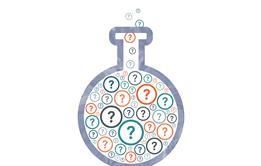Ask the age-old question, how does a teenage student sell bleach?
An ad agency is putting together an advertising campaign for a new bleach. They contact the students for help with determining the amount of NaOCl in various bleach samples (found by reacting a known quantity of each bleach with hydrogen peroxide and measuring the amount of oxygen produced). Using this information, the students are asked to determine if the new bleach is better value for money.
Pre-Lab questions
(Remember to give full references for any information beyond A-level that you find out)
- For each of the species below, indicate the oxidation state of the chlorine atom;
| Cl– | ClO2– | ClO4– |
| Cl2 | ClO2 | |
| ClO– | ClO3– |
- The active ingredient in household bleach is sodium chlorate(I), NaOCl, which is sometimes also known as sodium hypochlorite. This is formed when chlorine reacts with cold, dilute sodium hydroxide.
- Write an equation for the reaction which occurs (HINT: NaOCl is not the only product).
- This reaction is an example of a disproportionation reaction. Explain why.
- Sodium chlorate is such a strong oxidising agent that it will oxidise hydrogen peroxide. In this process the chlorate(I) anion, ClO– is reduced to a chloride anion and the hydrogen peroxide is oxidised to oxygen gas. The sodium ion is a spectator ion in the reaction.
- Write two half equations for the reduction and oxidation processes respectively and combine to give a full redox equation for the reaction occurring.
- A student reacts 20.0 cm3 of bleach with an excess of hydrogen peroxide and measures the volume of oxygen produced. According to the label, the bleach contains 5% by volume of NaOCl (molar mass 74.5 g mol–1).
- i. What volume of NaOCl is present in the 20.0 cm3 solution of bleach?
- ii. If NaOCl has a density of 1.27 g cm–3, what is the mass of sodium chlorate used in the reaction? How many moles of sodium chlorate(I) is this?
- iii. The student reacts the bleach solution with an excess of H2 O2. What is the minimum volume of a 1.67 mol dm–3 (often labelled 20 vol) solution of hydrogen peroxide that the student must have used?
- iv. Assuming the sodium chlorate is the limiting reactant and the reaction is run at room temperature and pressure, what volume of oxygen gas will be produced?
Equipment
Chemicals
- 20 cm3 of each of three different bleaches. These can be the actual brands or solutions of sodium hypochlorite diluted to appropriate strengths. If possible aim for a thin bleach as with the thicker bleaches mixing is more difficult. Suitable bleaches would be;
- Domestos original (sodium hypochlorite concentration = 4.5 g per 100 g) [Irritant]
- Milton sterilising fluid (sodium hypochlorite concentration = 2 g per 100 g) [Irritant]
- A 3.5 w/w solution of sodium hypochlorite (3.5 g of sodium hypochlorite made up to 100 g with water) labelled “Best Bleach” [Irritant]
- 60 cm3 of 20 vol hydrogen peroxide [Irritant]
Apparatus
- 1 × 5 cm3 plastic syringe for the measurement and delivery of the hydrogen peroxide
- 1 × 5 cm3 plastic syringe for the measurement of the bleach solution
- Rubber bung to fit a 100 cm3 Büchner flask with one hole of an appropriate size to tightly fit the neck of the
- plastic syringe used for delivery of the hydrogen peroxide
- 100 cm3 Büchner flask
- Delivery tubing to fit the side arm of the Büchner flask
- 100 cm3 measuring cylinder
- Water trough
- Bee hive
- Access to deionised or distilled water
- Clamp and stand
Health, safety and technical notes
- Read our standard health and safety guidance
- Wear eye and clothing protection at all times.
- The concentrations of bleach used in this experiment will remove colour from clothing. Therefore, the students need to take special care to protect their clothing from bleach spills.
- The equipment provided must allow the students to add the hydrogen peroxide solution to the bleach in a sealed environment (the reaction is too quick to mix and then quickly bung the flask). This can either be achieved by the method illustrated or by using a pressure equalised dropping funnel. The equipment list will therefore need to be modified to fit the equipment available.
- 3-5% bleach solutions and 20 vol hydrogen peroxide solution are irritating to the eyes and skin, see CLEAPSS Hazcard HC050
- For more information on sodium hypochlorite see CLEAPSS Hazcard HC089
Put this in context
Watch the video of forensic toxicologist, Calum who discusses how he helps ensure public safety through the toxicological testing of everyday items like food, cosmetics, and textiles to ensure they are safe to use and consume.
Extension discussion points
- Should the hydrogen peroxide be added to the bleach or vice versa
- Is the volume of gas generated the volume measured in the gas syringe / measuring cylinder?
Downloads
Problem Based Practical Activities Problem 3 teacher & tech sheet
PDF, Size 0.3 mbProblem Based Practical Activities Problem 3
PDF, Size 0.19 mb
Additional information
This resource was developed by Catherine Smith, RSC School Teacher Fellow at the University of Leicester 2011 – 2012, produced as part of the National HE STEM Programme

Problem based practical activities

Discover how chemistry can relate to real world problems, so students can put their science knowledge into context.
- 1
- 2
- 3
 Currently
reading
Currently
reading
Cleaning solutions
- 5
- 6
- 7
- 8
- 9
- 10
- 11











































No comments yet